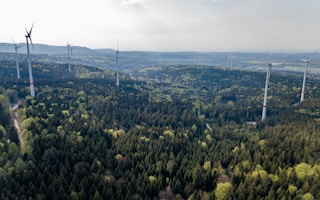Wind and solar power reached a record 12 per cent of global electricity generation last year, according to Ember’s global electricity review 2023. This drove up the overall share of low-carbon electricity to almost 40 per cent of total generation.
With even faster growth set to continue this year, Ember says 2022 is likely to mark a “turning point” when global fossil fuel electricity generation peaked and began to fall.
The think tank forecasts that, by the end of 2023, more than 100 per cent of the growth in electricity demand will be covered by low-carbon sources.
Experts broadly agree that global electricity generation needs to be completely decarbonised by 2040 if the world is to stay on track for its climate targets.
Ember says rapidly expanding renewables mean that the “phasedown” of gas as well as coal power required for this transition is “now within reach”. However, it also says stalling nuclear and hydropower construction needs to be reversed.
Meeting demand
Global electricity demand has been rising for decades, due to rising populations, increasing industrialisation and higher incomes.
Moreover, this trend is set to continue, particularly as more people switch their fossil fuel-driven cars and heaters to electric models. Demand will also increase as power is supplied to the 775 million people who still lack access to electricity.
To date, electricity demand growth has generally outpaced the rapid expansion of low-carbon sources, meaning emissions from the power sector have continued to rise. Any shortfall in meeting growth with low-carbon sources has been met by fossil fuels.
Yet low-carbon sources must ultimately begin to not only meet rising electricity demand but also start squeezing fossil fuels out of the mix, if global carbon targets are to be met.
In 2022, the expansion of wind and solar met 80 per cent of the increase in electricity demand, Ember’s report shows. Combined with hydropower and bioenergy, renewables met 92 per cent of the rise, coming close to covering rising demand.
At the same time, there was also a global drop in nuclear generation linked to outages in France and closures in Germany and Belgium.
As a result, power sector emissions climbed once again in 2022.
This year, however, Ember estimates that record growth in low-carbon power generation will cause fossil fuel output to dip by 0.3 per cent. This “critical tipping point” can be seen in the chart below.
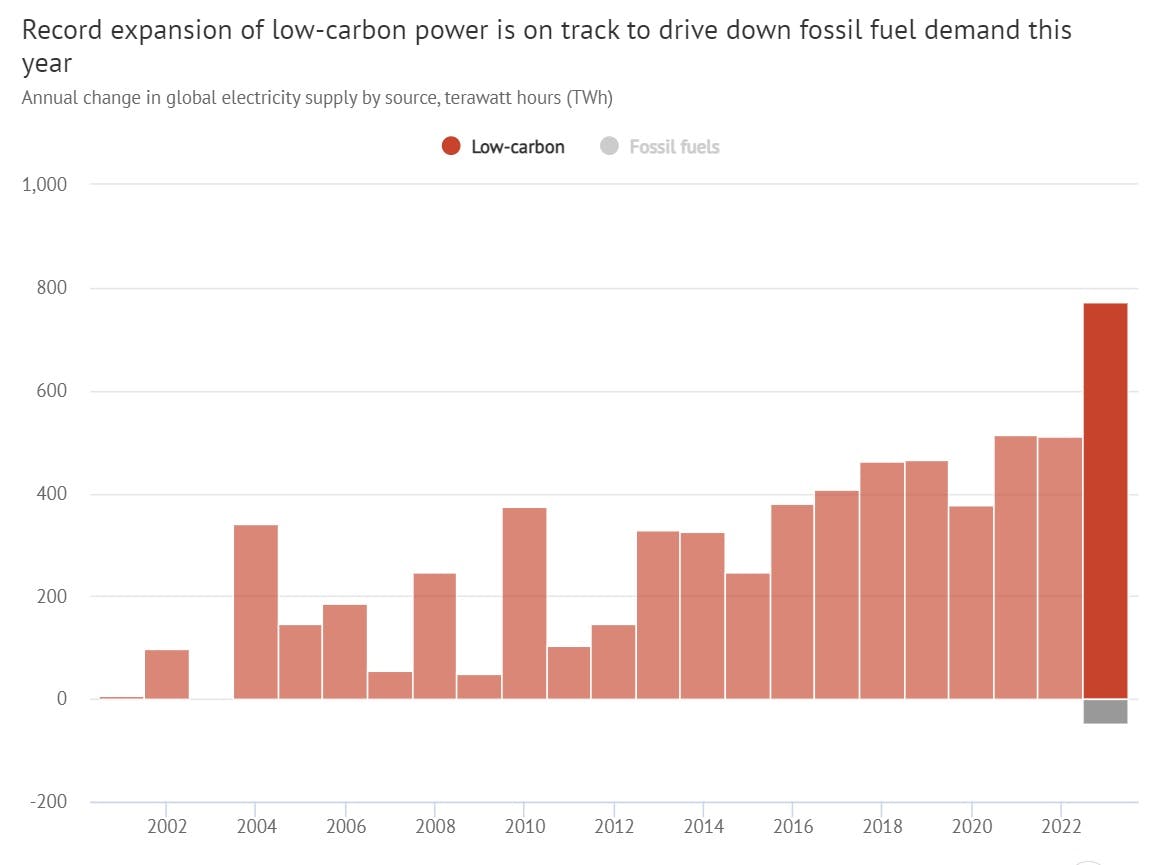
Annual change in global electricity supply, in terawatt hours (TWh), for fossil fuels and low-carbon sources. Source: Ember. Chart by Carbon Brief using Highcharts.
Ember forecasts low-carbon sources will grow by a record 773 terawatt hours (TWh) in 2023, larger thanthe electricity demand of Brazil. This would be an even faster expansion than the Germany-sized 500TWh low-carbon growth in 2021 and 2022.
While a drop in 2023 would not be the first time fossil fuel generation has fallen, the think tank says that it would be the “first time for this to happen at a structural, enduring level”. Previous declines have only occurred during widespread recessions, as in 2008 and 2020, or for other cyclical reasons, as in 2019.
Moreover, Ember forecasts that this is the beginning of long-term decline in fossil fuel usage in the power system. The continued expansion of wind and solar “could mean power sector emissions will never peak higher than they did in 2022”, it concludes.
It notes that 2022 was an “accelerator year” for renewables. This was driven in part by the energy crisis, as well as major policy packages such as REPowerEU and the US Inflation Reduction Act.
All this means the year “will be remembered as a turning point in the world’s transition to clean power”, the think tank notes.
Ember’s projections out to 2026 can be seen in the chart below.
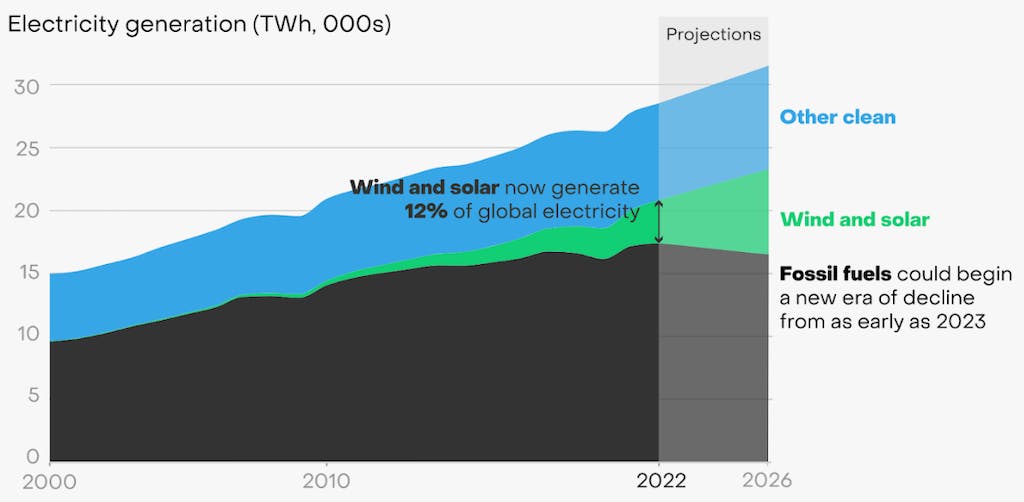
Global electricity generation, thousands of TWh 2000-2026, with Ember’s projections indicated by the lighter shade. “Other clean” includes nuclear, hydro, bioenergy and other renewables, such as geothermal. Source: Ember.
Fossil fuel phasedown
With the fossil fuel tipping point not quite reached, power sector emissions still reached an “all-time high” in 2022, rising 1.3 per cent.
The year saw mixed results for fossil fuels. Ember notes that coal-fired generation grew 1.1 per cent, while gas power output dropped by 0.2 per cent amid record prices driven by Russia’s invasion of Ukraine.
Ember notes that the “phasedown” of coal power, pledged by world leaders at COP26, did not materialise in 2022. It also points to figures showing that China, the biggest user of coal, retired just 0.1 per cent of its fleet in 2022 and continued to build new capacity.
(Some 77 per cent of China’s electricity demand growth in 2022 was met by low-carbon sources, Ember notes, mainly wind and solar.)
The chart below shows this in the left panel. The right panel shows coal power capacity changes outside China, where net capacity continued to shrink (red line) but more slowly than in recent years.
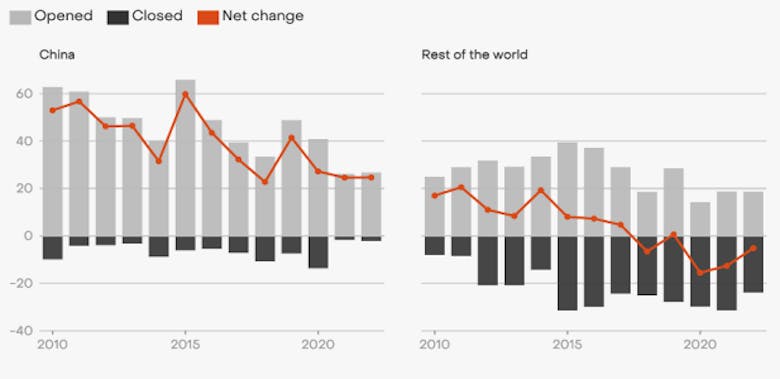
Global coal capacity added and lost each year, gigawatts (GW), 2000-2022. The red line indicates net change when both additions and losses are considered. Source: Ember.
Nevertheless, Ember also points out that surging gas prices did not prompt a major return to coal, as some had feared. The report adds that the decline in fossil fuel power it is forecasting will mean cuts for gas as well as for coal:
“Falling fossil generation means not only that the coal power phasedown will happen, but also that – for the first time – a gas power phasedown is now within reach.”
Last year saw just 31GW of new gas plants being added globally, Ember says, adding that this is the lowest amount since 2004.
It says that this trend implies a “more equal fall in both coal and gas power” in the coming years. It notes that the International Energy Agency’s (IEA) net-zero power sector scenario involves a near-phaseout not only of unabated coal, but unabated gas as well by 2040.
Low-carbon laggards
The IEA net-zero emissions scenario, which is in line with the Paris Agreement 1.5C target, points to a net-zero power sector by 2040. This date is brought forward to 2035 for wealthy countries in the Organisation for Economic Co-operation and Development (OECD).
Wind and solar are expected by the IEA to provide around three-quarters of the new electricity generation over this time period.
However, hydro and nuclear power are also viewed as having a key role in this transition, according to Ember. As things stand, the think tank says these technologies “are not currently being expanded at the rate needed to limit global warming to 1.5C”.
Its new analysis shows that low-carbon electricity sources excluding solar and wind “saw their first year-on-year fall in generation since the Fukushima nuclear disaster in 2011”.
This drop in 2022 was linked to nuclear shutdowns and drought-related hydropower declines. But construction of these projects has also slowed down in recent years, Ember says, as shown in the figure below.
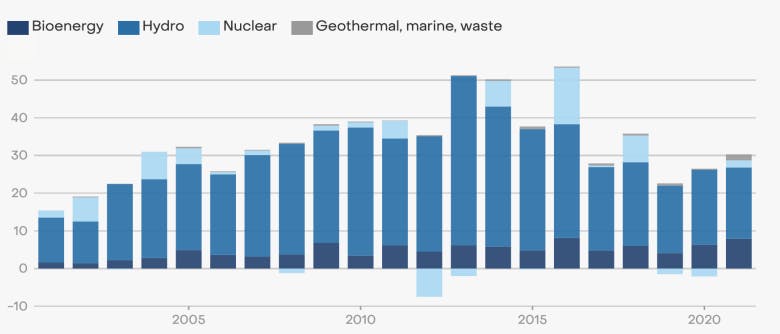
Year-on-year change in global capacity of low-carbon power sources, excluding wind and solar, 2000-2022. Source: Ember.
Overall, Ember says such a slowdown “could have big implications for the electricity transition”. It calls for a fivefold rise in hydropower investment and a nuclear “renaissance”, including life extensions of ageing plants and timely delivery of new projects.
This story was published with permission from Carbon Brief.

